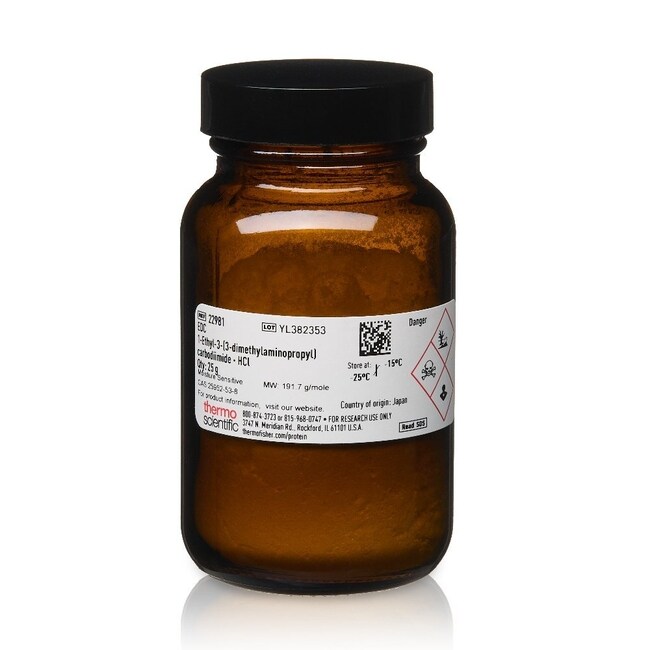Search Thermo Fisher Scientific
Pierce™ EDC, No-Weigh™ Format
| Catalog Number | Quantity |
|---|---|
| 22981 | 25 g |
| A35391 | 10 x 1 mg |
| 77149 | 10 mg |
| 22980 | 5 g |
Thermo Scientific No-Weigh products are specialty reagents provided in a pre-aliquoted format. The pre-weighed packaging prevents the loss of reagent reactivity and contamination over time by eliminating the repetitive opening and closing of the vial. The format enables use of a fresh vial of reagent each time, eliminating the hassle of weighing small amounts of reagents and reducing concerns over reagent stability.
Characteristics of EDC:
• Reactive group: carbodiimide
• Reaction target: activates carboxyl groups to conjugate to amino groups (primary amines)
• Several conjugation strategies—react EDC alone with target groups or include NHS or Sulfo-NHS to increase reaction efficiency or to stabilize active intermediate for later reaction to amines
• Neutral linkage—forms neutral amide bonds between carboxyls and amines
• Water-soluble reagent—add directly to reactions in aqueous, physiological buffers
• Soluble reaction byproducts—easily removed by washing with water or dilute acid
• High-purity, crystalline reagent—use to create high-quality, activated derivatives
Properties of EDC
• Molecular formula: C8H17N3·HCl
• Molecular weight: 191.7
• Spacer arm length: 0 Å
• CAS Number: 25952-53-8
• Reactive groups: carbodiimide
• Reactivity: Forms active intermediate with carboxyl groups at pH 4.7–6.0 (optimum), then intermediate reacts with primary amines
1-Ethyl-3-[3-dimethylaminopropyl]carbodiimide hydrochloride (EDC or EDAC) is a zero-length crosslinking agent used to couple carboxyl groups to primary amines. This crosslinker has been used in diverse applications such as forming amide bonds in peptide synthesis, attaching haptens to carrier proteins to form immunogens, labeling nucleic acids through 5' phosphate groups and creating amine-reactive NHS-esters of biomolecules. EDC reacts with a carboxyl to form an amine-reactive O-acylisourea intermediate. If this intermediate does not encounter an amine, it will hydrolyze and regenerate the carboxyl group. In the presence of N-hydroxysulfosuccinimide (Sulfo-NHS), EDC can be used to convert carboxyl groups to amine-reactive Sulfo-NHS esters. This is accomplished by mixing the EDC with a carboxyl containing molecule and adding Sulfo-NHS.
Applications:
• Conjugate carboxyl and amino groups among peptides and proteins
• Couple haptens to immunogenic carrier proteins (e.g., attach a peptide to KLH)
• Immobilize peptide antigens to affinity-purify antibodies
• Create NHS-activated, amine-reactive labeling compounds
• Crosslink proteins to carboxyl coated beads or surfaces
• Activate nanoparticles with amine-reactive Sulfo-NHS esters
• DNA labeling through 5' phosphate groups (see Tech Tip #30)
Product References:
Crosslinker Application Guide -- search for recent literature references for this product
Figures


Customers who viewed this item also viewed
Documents & Downloads
Certificates
Safety Data Sheets
Frequently asked questions (FAQs)
No. EDC is very unstable in aqueous environments and must be dissolved immediately before use. NHS and Sulfo-NHS are relatively stable in solution but best results are obtained when they are dissolved immediately before use. Store these compounds desiccated at 4°C.
Find additional tips, troubleshooting help, and resources within our Protein Assays and Analysis Support Center.
These compounds are used to modify a carboxyl group to form an amine-reactive ester. This is accomplished by mixing NHS with a carboxyl-containing molecule and the carbodiimide EDC (Cat. No. 22980, 22981, 77149, A35391). EDC causes a dehydration reaction between the carboxyl and the NHS hydroxyl group, giving rise to an NHS-ester-activated molecule. The activated molecule can then be reacted spontaneously with a primary amine-containing molecule. Although the carboxyl-molecules can be made to react directly with amines using EDC, the reaction is much more efficient with NHS because a stable intermediate is created. In fact, molecules that are activated as NHS esters can be dried and stored for later reaction to amine-containing targets.
Find additional tips, troubleshooting help, and resources within our Protein Assays and Analysis Support Center.
These compounds are used in conjunction with the crosslinker EDC (Cat. No. 22980, 22981, 77149, A35391) to synthesize amine-reactive labeling reagents, crosslinkers and conjugation compounds. Any compound containing a carboxylic acid (-COOH), such as a protein, or biotin or peptide, can be activated with NHS or Sulfo-NHS to form an NHS ester that will spontaneously react to form covalent amide linkages with proteins and other molecules that contain primary amines (-NH2).
Find additional tips, troubleshooting help, and resources within our Protein Assays and Analysis Support Center.
The CarboxyLink Resin is for immobilizing carboxyl-containing biomolecules after EDC activation. CarboLink Resin is hydrazide-activated and immobilizes glycoproteins. Carbolink has been replaced with glycolink immobilization kits and resins. Glycolink can also be used to immobilize steroids or other molecules containing ketones. Both resins are capable of coupling ligands via carboxylic acids using EDC (Cat. No. 22980). Both immobilization chemistries are available on UltraLink Resin as UltraLink Hydrazide (glycoproteins) and UltraLink DADPA (carboxyl) Resins.
Find additional tips, troubleshooting help, and resources within our Protein Purification and Isolation Support Center.
These resins are derivatized with diaminodipropylamine (DADPA). DADPA has a terminal primary amine that enables covalent immobilization of peptides or other carboxyl-containing (-COOH) molecules. When incubated with the resin and the carbodiimide crosslinker EDC (included in the CarboxyLink Immobilization Kit), carboxyl-containing molecules become permanently attached to the resin by stable amide bonds. The immobilized molecules can then be used in affinity purification procedures. CarboxyLink/DADPA UltraLink Coupling Resins can also be used to immobilize other kinds of molecules using alternative amine-reactive crosslinking chemistries.
Find additional tips, troubleshooting help, and resources within our Protein Purification and Isolation Support Center.



